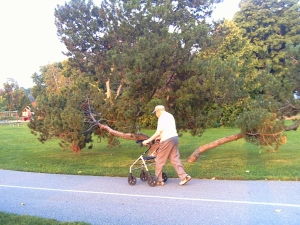For elderly adults who live on their own or in nursing homes and assisted-living facilities, falls can result in serious and life-threatening injuries. While falls are not the result of elder abuse, they can occur when there is a clear issue of nursing home neglect. A recent article in the New York Times emphasized that the number of reported falls among older adults—many of those accidents leading to serious and sometimes fatal injuries—is a number that is “soaring.”
Nursing Home Regulations  Aimed at Preventing Falls
Aimed at Preventing Falls
How can nursing homes take steps to prevent dangerous falls? The New York Times article discusses the policies put in place recently by a retirement community which require that, during mealtimes, residents who use walkers to get around must have their walkers “valet parked” after they find a seat at the table. In addition, they are not permitted to use their walkers during the meal—they must stay in their seats while staff members serve them. While many residents of the facility argued that the policy “infringed on [one’s] freedom of movement,” it prevented a number of serious falls at the buffet.
What about at non-mealtimes, when nursing home and assisted-living facility residents might not be under such close monitoring? Many of these facilities are struggling to balance residents’ freedoms with the risk of a serious fall. In particular, most of the rulemakers at these facilities—in California and across the country—know that, when an elderly resident suffers an injury during a preventable fall, that resident may be able to file a claim for nursing home neglect.
Experts indicate that nursing homes throughout the U.S. are beginning the process of creating rules and regulations aimed specifically at preventing falls, given that the number of fall-related injuries have risen dramatically in recent years. For some facilities, this means trying to anticipate hazardous conditions, and hiring architects and designers who can outfit a facility in a way that is safer for elderly residents.
Structural and design changes can take the form of automatic floor lighting that helps to guide seniors from the bed to the restroom, for instance, or energy-absorbing floors that reduce the impact from a fall. For other facilities, changes take the form of rules like the one that prevents residents from using their walkers during mealtime.
Facts and Figures Concerning Elderly Falls
Based on figures from the Centers for Disease Control and Prevention (CDC), a shockingly high number of older adults sustain fatal injuries in fall-related accidents. In 2012, about 24,000 seniors died from injuries they sustained after a fall. That number has doubled over the last decade. And the numbers are even higher for emergency room visits linked to serious falls. In 2012, more than 2.4 million adults over the age of 65 received emergency room treatment for injuries connected to a preventable fall. That number shows a 50 percent increase from 2002.
Over the last ten years, more than 200,000 seniors have sustained fatal injuries in preventable falls. Indeed, falls are “the leading cause of injury-related death in that age group.”
If your parent or elderly loved one suffered a serious fall at a nursing home or assisted-living facility, you should contact an experienced San Diego elder abuse lawyer. You may be able to hold the facility liable.
Image Credit: gracey via morgueFile
See Related Blog Posts:
 Southern California Nursing Home Abuse Lawyer Blog
Southern California Nursing Home Abuse Lawyer Blog








